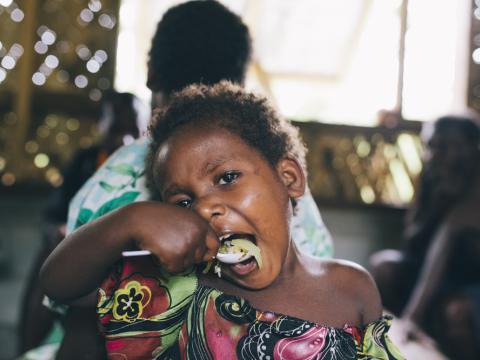Growing healthy communities with healthy island food

White rice, two-minute noodles and poor-quality tinned meat. This is all that thousands of communities in Vanuatu affected by Cyclone Pam had to eat, until their gardens destroyed by the disaster grow back.
The Pacific archipelago of Vanuatu is blessed with fertile volcanic soil. Root crops, fruit trees, coconut palms, and vegetable gardens grow in abundance. Some 80-percent of people in Vanuatu are subsistance farmers, meaning they grow food to eat and to sell at small markets.
Despite its fertile soil, Vanuatu, like many Pacific nations, is burdened by malnutrition.
Twenty-nine-percent of children under-five years are stunted, mostly due to a lack of protein in their diet. At the same time, 21 percent of adults in Vanuatu have diabetes, the eighth highest prevalence in the world, as families trade their fruits and vegetables for increasingly accessible nutrient-poor imported foods.
These same imported foods are now being distributed to communities to meet their energy needs following Cyclone Pam. Such food distribution is essential, but can potentially worsen nutritional issues.
Nutrition has been an important part of World Vision's work in Vanuatu for many years. On the island of Tanna in Vanuatu’s south, World Vision’s Tanna Helti Komuniti project saw stunting rates decrease by 9 percent and wasting decrease by 7 percent - small figures that represent huge progress.
The number of mothers who exclusively breastfed their babies to 6 months old increased from 52 percent to 92 percent!
World Vision doesn’t just work with families to improve the health of children. We work with entire communities including leaders like chiefs to promote the importance of good nutrition for children. We also work with local and national government in Vanuatu to advocate for policy that will make a big impact to the health of children.
In 2014, World Vision led national nutrition advocacy efforts, successfully supporting the Ministry of Education to introduce a national policy prohibiting sweetened drinks in kindergartens and schools, and partnering with the Ministry of Education’s Early Childhood Department to develop a national food and nutrition curriculum for kindergartens.
World Vision has produced two important nutrition awareness campaigns for television and radio, and in the weeks prior to Cyclone Pam finalised a flipchart in the national language, Bislama, to assist staff and health workers provide nutrition education to communities.
Following Cyclone Pam, World Vision worked with the Nutrition Cluster and other groups to ensure the health of children was looked after. We’ve supported the main hospital in Tanna to identify and treat children who are severely malnourished.
And as families receive emergency food like rice, World Vision is helping to distribute seeds and tools so families can grow back their gardens as soon as possible.
For World Vision Vanuatu, every week is a week where we focus on Child Health, but as we celebrate World Vision’s Global Week of Action we are planning nutrition activities for the short- and long-term recovery periods, particularly relating to agriculture.
Because while there may be challenges, World Vision looks forward to many more years successfully supporting good nutrition in Vanuatu.
About the author: Tarli O’Connell is World Vision Vanuatu’s Nutrition Advisor and is leading World Vision’s nutrition programming in our Cyclone Pam response.